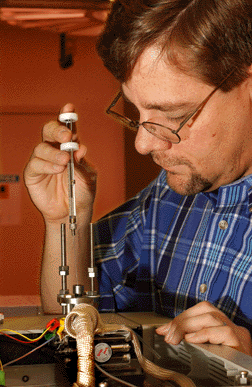FOR IMMEDIATE RELEASE
March 6, 2002
Prototype detector could identify anthrax quickly
New technique requires only a few minutes of FAME
|

Just a few minutes of FAME — Sandia researcher Curtis Mowry deposits biological material to be rapidly analyzed on the “hot plate” portion of Sandia’s prototype anthrax detector. (Photo by Randy Montoya)
Download 300dpi JPEG image, ‘AnthraxDetection.jpg’, 1.5MB (Media are welcome to download/publish this image with related news stories.)
|
ALBUQUERQUE, N.M. — Some deadly things don’t deserve 15 minutes of FAME, let alone several hours.
A prototype handheld detector under development at Sandia National Laboratories can identify the fatty acid methyl esters (FAME) of anthrax in less than five minutes.
Identification of the bacillus in minutes, rather than the hours currently necessary, is a crucial step in alerting a building’s occupants to flee the deadly bacteria, as well as in activating defenses such as anti-anthrax foam dispersal systems. The patent-applied-for detector, in which commercial interest has been expressed, would also aid security people making their rounds to locate point sources of the disease.
Like burning bacon
The technique works by preconcentrating airborne particles on a tiny hotplate that acts like a skillet on a stove. The hotplate immediately vaporizes the fatty acids in anthrax’s cell walls to create the FAME that form a unique fingerprint of the bacteria.
“The process is a little like burning bacon,” says lead researcher Curtis Mowry of the microchemistry lab. “The wafted gases are distinctive to a detector.”
A small computer program correlates the amount of mass of each ester emitted in the analyzed gases at particular times — a process called elution — with already categorized elution peaks indicative of anthrax or other diseases.
Pyrolization is not only far faster than current suitcase-sized prototype devices but requires considerably less power — 150 milliwatts instead of 130 watts. The extremely low power is made possible by microdevices fabricated at Sandia.
Components of the device have been individually tested, though not yet linked with a commercially available aerosol collector.
Faster is better
“The focus of the project is on increasing the speed of analysis in the microfabricated system while retaining enough information to distinguish between microorganisms,” says Mowry.
Standard techniques require a lengthy extraction/derivatization step followed by FAME chromatography. Sandia’s chemographic and surface acoustic wave analysis of gasses driven from the bacteria enables far more rapid identification of anthrax and other diseases.
Fatty acids are found in all living organisms with cell membranes. Analyses of gases driven from the bacteria have been used to identify bacteria and other pathogens at the genus level, and often at the species level.
Sandia’s Laboratory Directed Research and Development program supported the work. Initial results were reported at the SPIE conference in Boston in November.
Sandia is a multiprogram laboratory operated by Sandia Corporation, a Lockheed Martin Company, for the United States Department of Energy under contract DE-AC04-94AL85000. With main facilities in Albuquerque, N.M., and Livermore, Calif., Sandia has major research and development responsibilities in national security, energy and environmental technologies, and economic competitiveness.
Sandia Media Relations Contact: Neal Singer, nsinger@sandia.gov, (505) 845-7078
Sandia Technical Contact: Curtis Mowry, cdmowry@sandia.gov , (505) 844-6271
| 